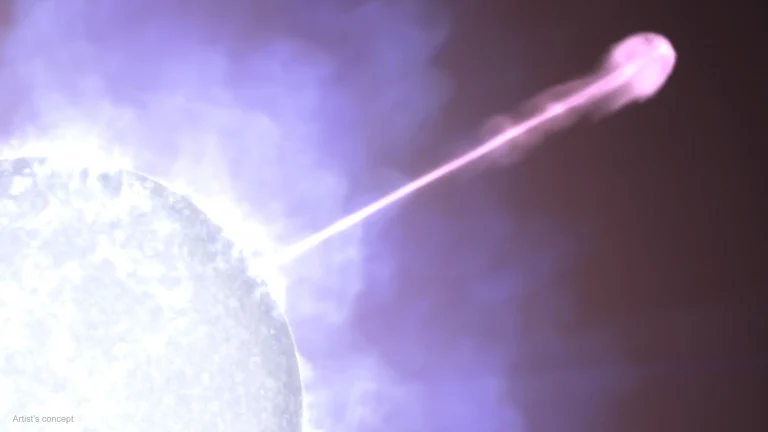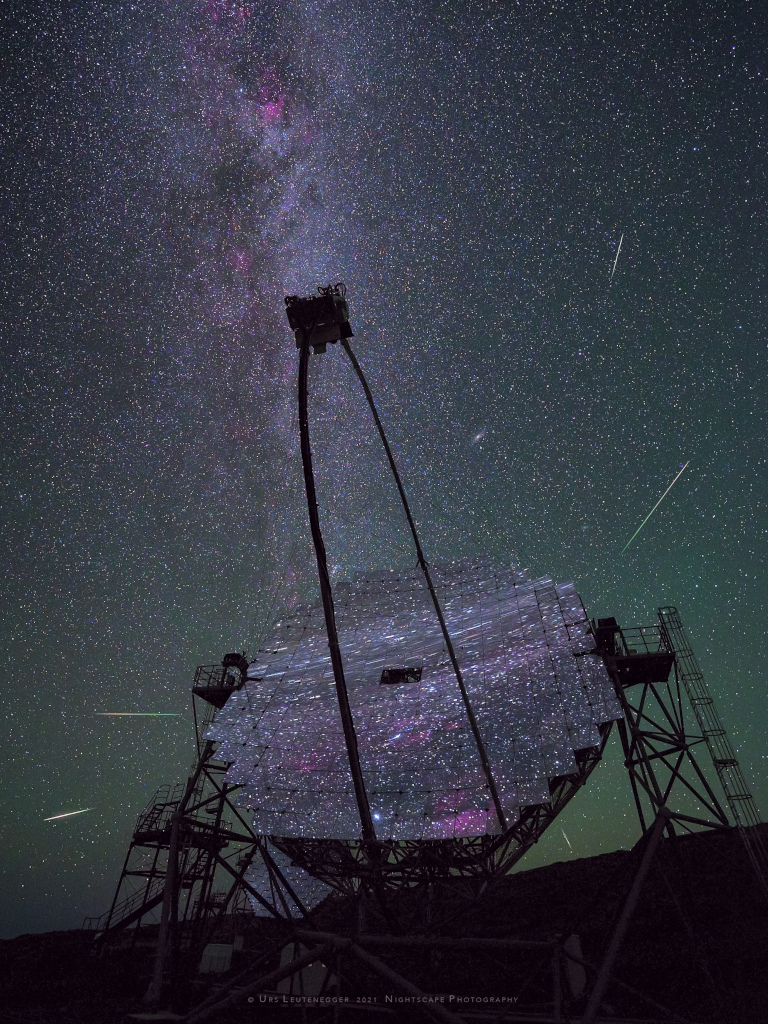超新星遗迹CTA 1
See Explanation. Clicking on the picture will download the highest resolution version available.
请参阅说明。单击图片将下载可用的最高分辨率版本。

See Explanation. Clicking on the picture will download the highest resolution version available.
请参阅说明。单击图片将下载可用的最高分辨率版本。

A blue oval is shown with a red and yellow horizontal band running across the middle. Red and yellow spots also appear distributed inside the oval. Please see the explanation for more detailed information.
图中显示的是一个蓝色椭圆形,中间有一条红色和黄色的水平带。椭圆形内部还分布着红色和黄色的斑点。有关更多详细信息,请参阅说明。

A large and orange-tinted moon is pictured rising beyond the pillars of an ancient structure. The foreground is dark and the night sky behind the Moon appear blue. Please see the explanation for more detailed information.
照片中,一轮巨大的橙色月亮从古老建筑的柱子上方升起。前景很暗,月亮后面的夜空呈蓝色。有关更多详细信息,请参阅说明。

2022年10月,天文学家迅速被称为BOAT的有史以来最亮的伽马射线暴(GRB)震惊了。现在,一个国际科学团队报告称,来自NASA的费米伽马射线太空望远镜的数据显示出一个前所未见的特征。

2023年9月6日 HESS Telescopes Explore the High-Energy Sky Credit & Copyright: Video Credit & Copyright: Jeff Dai (TWAN), H.E.S.S. Collaboration; Music: Ibaotu catalog number 1044988 (Used with permission) Explanation: They may look like modern mechanical dinosaurs, but they are enormous swiveling eyes that watch the sky. The High Energy Stereoscopic System (H.E.S.S.) Observatory is composed of four 12-meter reflecting-mirror telescopes surrounding a larger telescope housing a 28-meter mirror. They are designed to detect strange flickers of blue light — Cherenkov radiation –emitted when charged particles move slightly faster than the speed of light in air. This light is emitted when a gamma ray from a distant source strikes a molecule in Earth’s atmosphere and starts a charged-particle shower. H.E.S.S. is sensitive to some of the highest…

2022年8月11日 Perseids and MAGIC Image Credit & Copyright: Urs Leutenegger Explanation: On August 11, 2021 a multi-mirror, 17 meter-diameter MAGIC telescope reflected this starry night sky from the Roque de los Muchachos European Northern Observatory on the Canary Island of La Palma. MAGIC stands for Major Atmospheric Gamma Imaging Cherenkov. The telescopes can see the brief flashes of optical light produced in particle air showers as high-energy gamma rays impact the Earth’s upper atmosphere. To the dark-adapted eye the mirror segments offer a tantalizing reflection of stars and nebulae along the plane of our Milky Way galaxy. But directly behind the segmented mirror telescope, low on the horizon, lies the constellation Perseus. And on that date the dramatic composite nightscape also captured meteors streaming from…

从NASA的费米太空望远镜拍摄的时间序列中可以看到,伽马射线下的月球发出明亮的光芒。每张5×5度的图像以月球为中心,显示了能量超过3100万电子伏的伽马射线,是可见光的几千万倍。在这些能量下,月球实际上比太阳还要亮。较亮的颜色表示伽马射线的数量较多。该动画显示了在从2个月到128个月(10.7年)的较长曝光时间下,成像得到了怎样的改善。 版权:NASA/美国国防部(DOE)/Fermi LAT Collaboration 如果我们的眼睛能看到被称作伽马射线的高能辐射,就会发现月球就比太阳更亮!美国国家航空航天局(NASA)的费米伽马射线太空望远镜(Fermi Gamma-ray Space Telescope)在过去的十年里就是通过这种方式来对我们的邻居-月球进行观测的。 由于伽马射线的观测不够灵敏,无法清楚地看到月球的形状或任何表面特征。相反,费米的大面积望远镜(LargeArea Telescope,LAT)探测到一个以月球在天空中的位置为中心的耀眼辉光。 位于巴里的意大利国家核物理研究所(National Institute of Nuclear Physics)的马里奥·尼古拉·马齐奥塔(Mario Nicola Mazziotta)和弗朗西斯科·洛帕科(Francesco Loparco)一直在对月球的伽马射线进行分析研究,以更好地理解来自太空的另一种辐射:被称作宇宙射线的快速移动粒子流。 Mazziotta解释道:“宇宙射线主要是由宇宙中一些最具能量的现象得到加速的质子,比如恒星爆炸时产生的冲击波和物质落入黑洞时产生的喷流。” 由于这些粒子是带电的,它们会受到磁场的强烈作用。月球上缺少磁场,因此,即使低能宇宙射线也能到达月球表面,使月球变成一个便利的太空粒子探测器。当宇宙射线撞击月球时,它们与覆盖月球表面的粗糙细小尘埃(称为风化层)相互作用,发射出伽马射线。月球本身会吸收大部分伽马射线,但其中一部分会逃逸至太空中。 [rml_read_more] Mazziotta和Loparco对Fermi太空望远镜的LAT月球观测结果进行了分析,以表明在任务执行期间,望远镜的视野是如何改善的。他们收集了能量超过3100万电子伏特的伽马射线(比可见光的能量大1000多万倍)的数据,并把这些数据按照时间的推移整理好,展示了长时间的曝光是如何改善望远镜成像的。 Loparco表示:“从这些能量来看,月球永远不会经历可见光下那样的每月盈亏周期变化,并且会看起来总是满月。” 这些图像显示,NASA的Fermi伽马射线太空望远镜拍摄到的月球伽马射线辉光成像图正在稳步改善。每张5×5度的图像以月球为中心,显示能量超过3100万电子伏特的伽马射线,是可见光的几千万倍。在这些能量下,月球实际上比太阳还要亮。较亮的颜色表示伽马射线的数量较多。该图像序列显示了从两个月到128个月(10.7年)较长时间的曝光,是如何改善望远镜成像的。 版权:NASA/DOE/Fermi LAT Collaboration 随着NASA通过阿尔特弥斯计划(Artemis)将目标设定为于2024年前将人类送上月球,最终实现将宇航员送上火星的目标,了解月球环境的各个方面具有了新的重要意义。这些伽马射线观测提醒我们,宇航员在月球上需要保护自己不受产生这种高能伽马射线的宇宙射线的伤害。 虽然月球发出的伽马射线令人惊讶且印象深刻,但太阳发出的能量超过10亿电子伏特的伽马射线的确更加明亮。由于太阳强大磁场的屏蔽作用,能量较低的宇宙射线无法到达太阳。但是更多的高能宇宙射线可以穿透该磁屏蔽层,撞击太阳密度较大的大气层,产生可以到达Fermi太空望远镜的伽马射线。 虽然伽马射线下的月球没有显示出每月的相位循环,但其亮度确实会随着时间而变化。Fermi太空望远镜的LAT数据显示,在太阳11年的活动周期中,月球的亮度变化约20%。这期间太阳磁场强度的变化会改变宇宙射线到达月球的速度,从而改变伽马射线的产生。 来源: https://www.nasa.gov/feature/goddard/2019/moon-glows-brighter-than-sun-in-images-from-nasas-fermi